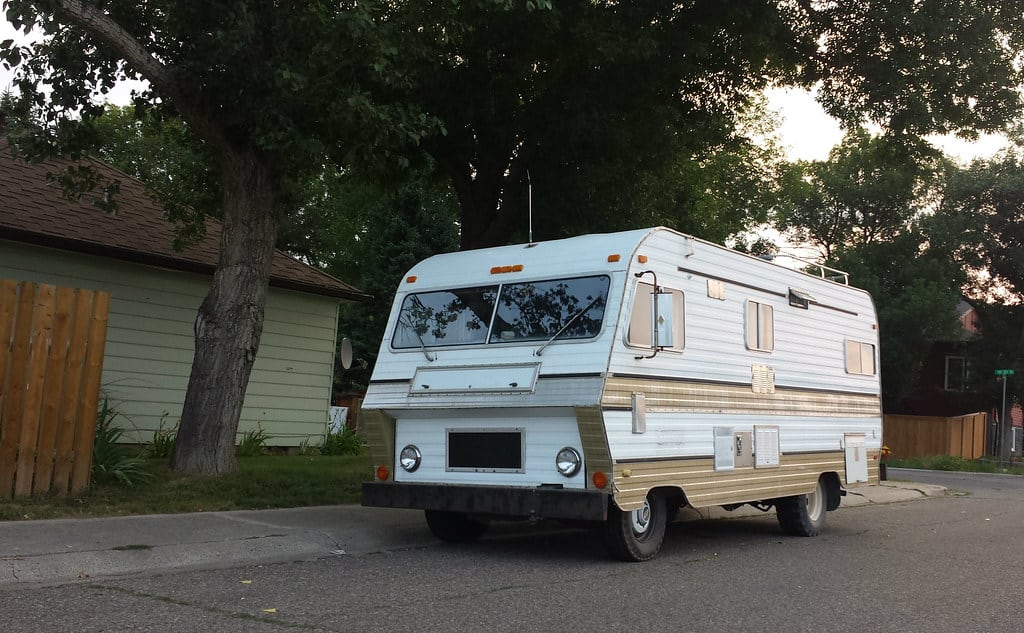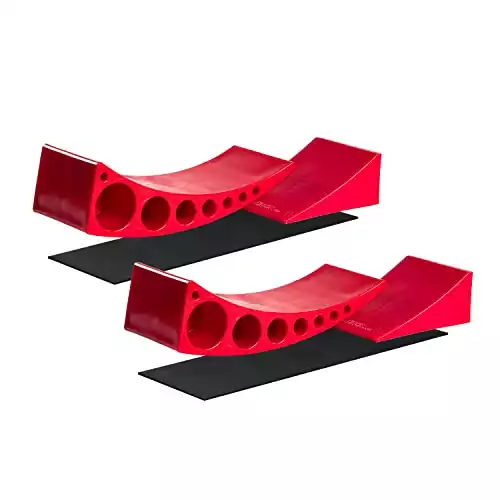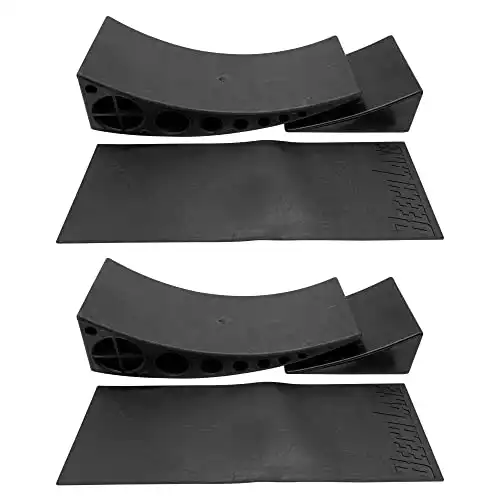Finding uneven ground upon arrival at a campsite is not a reason to leave. On sloping terrain or soft ground, RV leveling blocks can assist in keeping the RV leveled and balanced. Some create a progressive succession of flat surfaces when they stack and connect. They create a mini-ramp for your tires to rest on.
I have visited several campgrounds where I found it hard to make my RV rest evenly. Initially, this used to worry me until I discovered the wonder of leveling blocks. Selecting the right one may be challenging, considering the many leveling blocks available. If you are in this situation, fret not because I am here to make your life easier.
In this article, I share my insights on all things to do with leveling blocks, including what they are, why you need them, which features to look for when buying, and how to install them are all things I explain in this article. I list five major brands’ advantages and disadvantages based on my testing, research, and recommendations from friends and fellow campers.
What Are RV Leveling Blocks?
On uneven ground, leveling blocks help your RV stay level. One type is wood blocks, which are simple to make with a table saw. They are also affordable. Wooden RV leveling blocks weigh a lot and eventually crack or rot. Additionally, you might not have the time or resources to make these wooden blocks.
Plastic leveling stacker pads are an additional type. They are simple to pack because of their lightweight and compact stacking design. Unfortunately, they sink into soft surfaces due to their waffle-like grid bottom. When it’s time to break camp, the bottom retains a lot of soil and is particularly prone to cracking if your RV is heavy.
The utility blocks are travel trailer leveling blocks that combine the advantages of being light and nearly indestructible. They have sidewalls with a slight slope, serving as a ramp for your RV. Thanks to a rope handle, they are simple to remove from beneath your RV. They include a slot your RV awnings rod can enter, allowing you to move the blocks, so you don’t need to crawl under your RV to adjust.
Why Do You Need Leveling Blocks?
Although your RV might have hydraulic or electric jacks, you still require camper leveling blocks. The two can only stabilize an RV that is already level. Occasionally, especially in locations with steep campgrounds, the RV inbuilt levelers are not powerful enough to level it.

Here are the main reasons you need RV levelers:
- Most older RV refrigerators are absorption models. Gas circulates via coils in them. However, the gas won’t flow if the RV isn’t level. Fridge issues can result in a fire, which can burn down your RV and perhaps result in more damage.
- Stuff doesn’t fall off the shelves when your RV is level.
- Getting water from containers through a tap in a level RV is easy.
- In a level RV, you sit, stand, and sleep more comfortably.
- You don’t have to worry about mechanical component damage because it is easier to remove the slides when your RV is level.
- You can comfortably camp in national parks or campgrounds that have not been pre-leveled.
Your newer RV model most likely features automatic levelers that you operate with a button. Contrary to what most people believe, you will need leveling blocks, even with the automatic levelers. There are times that you might need to lift your motorhome so high that its wheels no longer touch the ground.
You should place motorhome leveling blocks under the wheels to prevent the RV from rolling in such a situation. Automatic levelers don’t have the power to lift the RV so high and maintain it at that level.
Features To Look For When Choosing Leveling Blocks
The next step is to think about the ones with the best features when buying RV leveling blocks now that you know what they are and why you need them. Look for the features I’ve highlighted in the table below before choosing a particular type of leveling block.
| Essential Features | |
| Adequate breadth to fully support the tire’s width. | Consider the maximum load capacity to see whether it can support the weight of your RV, all of your belongings, as well as you and your family. |
| Lightweight but strong, so you can carry them easily | Find blocks made from sturdy materials to prevent splitting or deformation when the RV sits atop. |
| Water-resistant to avoid rotting | They shouldn’t be too big to make storing challenging. |
| Large enough to give your jacks a secure pad and a firm surface. | Pick a brand that offers a bag or carrying case. You’ll find it simpler to move and store your blocks. |
How To Install RV Leveling Blocks

The installation process is the same for trailer leveling blocks of all varieties. Here is an easy, step-by-step procedure.
- Remove any large rocks or other objects from the area close to where the blocks will go. Extend any slide-outs because they will impact the final level of your RV.
- For guidance on where to lift your RV, check it from side to side. It will be helpful to have a handheld level for this. Reinstall your slide-outs.
- Place the leveling blocks behind the wheels you want to lift.
- Put only one layer of blocks behind the wheel if it takes just one to level the RV. Place a longer first layer of blocks on the ground and a shorter second layer if you require more than one. As a result, your RV can ascend to the next level progressively.
- You must keep one wheel on the ground. Remember that you want to level the RV so that each of its four wheels is the same height.
- As you approach the center, slowly drive back your RV onto the blocks. Check to see if your RV is level. To prevent the elevated tires from toppling over, place a wheel chock in front of them (on the side opposite from where the lever is).
- If you have a towable RV, detach and level the trailer from front to rear using the tongue jack at the hitch.
- To further reduce any sway or wobble, extend your stabilizer jacks.
When you’re ready to leave the campground, reverse the order of all your leveling. Before moving on to the hitching tongue, the chocks, and the leveling blocks, start with the stabilizer jacks.
In the YouTube channel RV 101, Mark Polk demonstrates how to level a travel trailer.
The Most Popular Leveling Blocks
As I have found out, stabilizing jacks are not intended to level your RV on uneven ground. Your RV must be on flat ground for them to level it. They are primarily used to stabilize RVs that are already level. For maximum stability and to prevent damage to your RV, lower the stabilizer jacks after using the leveling blocks to level the wheels.

A well-known manufacturer of high-quality leveling blocks is Anderson Levelers. In addition, popular brands include Lynx, Camco, Beech Lane, and Carmtel. Here are the five brands’ advantages and disadvantages:
| Name of Leveler Block | Advantages | Disadvantages |
| Anderson | Easy to use. | Their highest lift is 4 inches. |
| They work with trailers weighing up to 30,000 pounds. | Can slip and sink on some surfaces. | |
| A tapered shape that allows you to level with accuracy. | Have some tire size restrictions. | |
| Your RV can be raised by up to 4 inches. | ||
| Sturdy. | ||
| Camco | Efficient, affordable, and portable. | More challenging to position than other levelers. |
| Include a handle for simple carrying. | You can only use one unit at a time; it is not stackable. | |
| Strong, resistant to breaking, and durable because it is a high-strength polymer. | ||
| Curved design that fits your tire’s shape and gives your RV a secure foundation. | ||
| Includes a chock to hold your RV in position after you’ve leveled it. | ||
| Lynx | Backup ramp block to keep the tire from rolling off. | Bright orange color fades in direct sunlight. |
| Stacking the blocks is easy because they interlock. | Not as durable as the other leveling blocks. | |
| Can support an RV weighing 40,000 lbs. | You shouldn’t use them with jacks. | |
| Ten-year warranty. | ||
| Beech Lane | 15 inches long and 6 inches broad, which you can trim to the size you want. | Block size is smaller when compared to other brands. |
| Grip marks are made of rubber to stop the levelers from sliding when you back up. | You’ll require multiple sets for dual-axle trailers. | |
| Handy carry bag | The traction mats don’t last very long. | |
| Supports an RV of up to 35,000 pounds. | ||
| Both the chocks and the wedge-style leveler are highly durable. | ||
| Made from bulletproof nylon polymer. | ||
| Carmtel Camper | Jointing system that prevents slipping to keep leveler blocks from shifting. | The notches on the two pieces don’t always line up correctly. |
| Made from high-performance polymer. | -Not easy to set up if you don’t read the manual properly. | |
| Works with trailers that weigh up to 35,000 pounds. | The levelers sometimes slip when placed on concrete or loose gravel. | |
| Can alter your leveling system to fit rigs with tight dual axles. |
Conclusion
Now that your RV is level, you can finally enjoy the coffee you’ve been craving all day! You can open the cabinet without all the cups falling on your face. By leveling your RV using the RV leveling blocks, all the equipment in your motorhome, including the refrigerator, water tanks, bathrooms, and doors, will work correctly. Just remember to choose the brand that best fits.
Frequently Asked Question
How do RV leveling blocks work, and why are they important for maintaining stability while camping?
RV leveling blocks keep your RV level in slopes or soft ground areas. Your RV won’t roll down the slope that way or sink into the dirt. Ideally, however, you should avoid soft landscapes.
The RV equipment can now work when leveling blocks keep the RV level. You won’t feel comfortable sitting, standing, or sleeping in an unleveled RV.
What are the advantages of using Anderson levelers for leveling an RV or camper?
Anderson levelers are portable and easy to operate. Stacking them will allow you to create a leveling surface that is unique to you. The leveling blocks offer an elevation of up to 4 inches.
What are the key features when choosing leveling blocks for a travel trailer or motorhome?
When selecting leveling blocks, a few key features to look for include lightweight, portability, and sturdiness to support the weight of your RV.
Additionally, you want to get RV leveling blocks that can withstand various weather conditions and not break down in wet, rainy environments or fade under direct sunlight.
How can Lynx levelers help achieve a perfectly level RV setup, and why are they popular among RV enthusiasts?
Lynx levelers come in packs of 4 and 10. Due to their square shape, you can simply stack them on top of one another to achieve the desired height. Drive your RV onto the stack. If you want better Lynx leveler performance, buy Lynx chocks, which fit perfectly with their leveling blocks.
They are most popular among RV enthusiasts because they are less expensive than most brands and are made of high-quality materials. Additionally, they effortlessly and safely level any kind of trailer.










